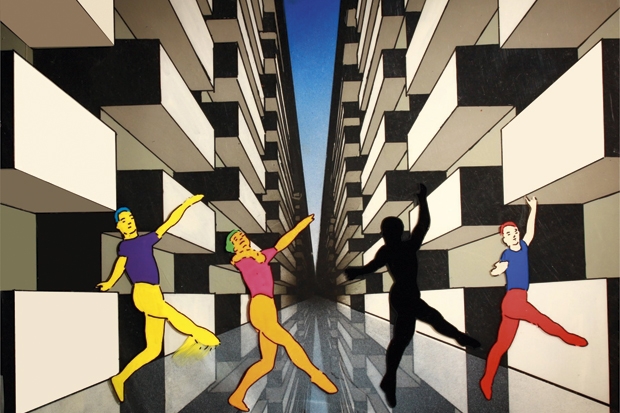In a crowded storeroom at Ikon, Birmingham’s contemporary art gallery, its director Jonathan Watkins is unwrapping the pictures for his latest show. His excitement is infectious. He’s like a big kid on Christmas day. This exhibition marks the start of Ikon’s 50th season, for which he’s devised a special programme — a history of Ikon, which doubles as a compact history of contemporary art.
To celebrate Ikon’s half-century, Watkins is mounting shows by five artists, one from each decade, who’ve exhibited here during the past 50 years. First up is the photorealist John Salt — the first artist ever shown at Ikon. He’ll be followed in April by Ian Emes, whose short animated film, French Windows, was made to accompany ‘One of These Days’, a song by Pink Floyd. Cornelia Parker’s ‘Thirty Pieces of Silver’ (now in the Tate collection) was commissioned by Ikon back in 1988. She’ll be reconstructing this artwork here in July. In September Yinka Shonibare takes centre stage with his strange interpretations of Britain’s imperial past (readers may recall his ship in a bottle on the spare plinth in Trafalgar Square, now on permanent display outside the National Maritime Museum). This retrospective concludes with Julian Opie, who was building his high-rise sculptures here in 2001 when the Twin Towers went up in flames. ‘We went upstairs and watched the whole thing unfold on TV,’ recalls Watkins. Opie will be back here in November.
Ikon’s 50th birthday is a convenient peg for this greatest hits collection, but Watkins has always had a keen interest in the gallery’s past. Ten years ago, he mounted a show devoted to Ikon in the 1960s. In 2010 he surveyed the 70s. This summer he’ll be reassessing Ikon’s output in the 1980s. Highlights include ‘Monument’, Susan Hiller’s moving tribute to men, women and children who’ve died performing acts of heroism, now also in the Tate.
Ikon’s history reflects Birmingham’s recent renaissance. Today the gallery is housed in a grand neogothic building in the rejuvenated city centre, but its premises weren’t always quite so smart. It started off in a kiosk in the Bullring, a shopping centre that became a byword for the worst aspects of Brutalism. After a few years in an old mortuary, it relocated to another shopping centre above Birmingham’s labyrinthine New Street Station. There, it was next door to an army recruitment office and was consequently bombed by the IRA (in what Watkins calls ‘a Duchampian twist of fate’, these premises later became a public toilet). In 1998, after a sojourn in a former carpet showroom, Ikon finally moved to its current home — one of Brum’s old board schools, built in 1878 for the education of the city’s worthy poor. Ikon’s evolution mirrors the fall and rise of Britain’s unfashionable second city, the butt of countless jokes — now, improbably, one of the most dynamic cities in the UK.
‘Who wants to go and live in Birmingham?’ was the reaction that Watkins encountered from his contemporaries when he became Ikon’s director in 1999. ‘If you say, “I’m going to live in Birmingham,” they say, “Oh well, I suppose somebody has to.”’ However he relished working in a city where art retained the power to shock and startle. ‘There are lots of opportunities to make a real difference here.’
During his 15 years at Ikon, he’s seen a softening of attitudes towards the work he’s championed, a lot less ‘anyone-could-do-that’ or ‘what-does-it-all-mean?’ ‘I haven’t had the same tabloid reaction recently,’ he says. ‘Our culture is catching up with contemporary art. It’s taken a while, but the provincialism of the UK — let alone Birmingham — which we experienced in the 70s and 80s has given way to a popular culture in which it’s OK to like contemporary art.’ Ikon has played a part in that sea change. ‘I don’t receive the same kind of complaints about our exhibitions that I did when I first arrived. I’ve had people come in and rip up photographs that they considered to be too sexy…People are giving us more benefit of the doubt.’
Watkins doesn’t want Ikon to become an ivory tower. He works with prisons and hospices. ‘I think we’ve made contemporary art feel a bit more like it has a place in everyday life.’ A narrowboat on the Grand Union Canal has become a floating studio for artistic teenagers. The derelict factories along its banks are being renovated as artists’ studios. In 1964, local artists founded Ikon because there was nowhere to show new art in Birmingham. Fifty years on, Ikon is the focal point for a vibrant new arts scene.





Comments